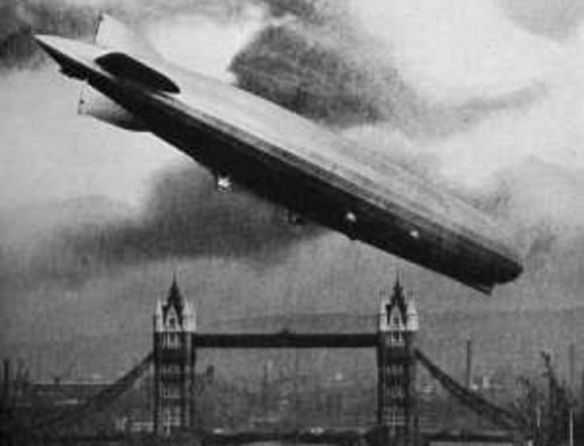
The Germans first attempted to break British morale by launching a series of Airship raids on Great Britain – (only Airships had the range and bomb capacity to attack Britain in 1915; heavier than air aircraft had not been developed enough to be used). By 1917 it was apparent that the airship raids had failed because they were too vulnerable to AA fire and British fighter aircraft, aided by searchlights. It is an interesting window into the future that the last German Airship to be shot down was shot down by a naval Lt. S D Culley, who took off at sea from a towed lighter flying a Sopwith Camel – the precursor of the aircraft carrier.
Following the failure of airships, the next German attempt to break British morale was to use heavy bombers, ‘Gothas’ and the very large ‘Giants’. These could carry 6 hundredweight (300 kilograms) bombs. Daylight attacks, starting in May 1917, failed due to British Home fighter defence and night attacks were accordingly started, the “Moonlight Raids” . However British defences included AA guns, formed into a barrier some 25 miles from London, were sited to split up the attackers and make them more vulnerable to fighter aircraft. The raids were tracked by Sound Locators and the defences in the path of the attack were alerted. The Sound Locators were very effective for identification of the Gothas but the Giants were so noisy that they initially confused their operators who thought that the Giants were Gothas but were much closer!
The biggest air-raid of the war was to be combined with the German March 1918 Offensive against the British on the Western Front; forty aircraft set out but only 13 reached London and ten crashed during or after the raid.
The statistics of the German aeroplane offensive are instructive, demonstrating how Airpower could not possibly have succeeded in attaining victory, nor indeed in inflicting any significant damage to the Britain’s war effort.
1916 – 19 attacks, three tons of bombs dropped – killed 27 and wounded 67.
1917 – 27 attacks, 51 tons of bombs – killed 655 people and wounded 1553.
1918 – 6 raids, 22 tons of bombs- killed 182 people and injured 430.
During the whole war, 9000 bombs, weighing 2890 ton, were dropped by 51 Airship and 52 Aeroplane attacks. London was bombed 12 times by Airship and 192 times by aeroplanes.
Overall, in Britain during WW1, 1413 were killed by the air raids, 3408 were injured and London lost 670 killed and 1962 injured.
Reference; “The German Air Raids on Great Britain – 1914-1918” by Joseph Morris, Sampson Low, & Co. Ltd. Circa 1920
Slightly different figures from THE SKY ON FIRE THE FIRST BATTLE OF BRITAIN 1917 – 1918, Raymond H. Fredette, 1966 (reprinted 1976):
‘Gotha and Giant Raids, 1917 – 1918′: 836 killed, 1,1982 injured, 2,818 total’; for London and Environs, 488 killed 1,437 injured, 1,925 total (including 24 killed and 196 by British antiaircraft fire, and 14 killed and 14 injured in air-raid shelter stampedes)
‘Raids by single-engined aeroplanes, 1915 – 1917′: 21 killed, 75 wounded, 97 total
‘Airship raids, 1915 – 1918′: 557 killed, 1,358 injured, 1,915 total
TOTAL casualties: 1,414 killed, 3,416 injured, 4,830 total (including military casualties of 354 killed and 642 wounded)
No source given for these numbers but the book’s bibliography does include Morris’s book which is listed with a copyright date of 1920.